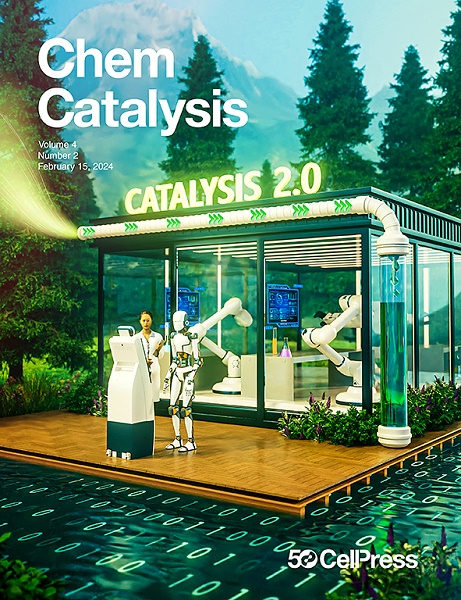利用双金属催化剂提高二氧化碳和乙烷生产碳纳米管的性能
IF 11.6
Q1 CHEMISTRY, PHYSICAL
引用次数: 0
摘要
将二氧化碳转化为碳纳米管(CNTs)提供了一种很有前途的二氧化碳利用和封存方法,有可能减轻人为排放对环境的影响。本研究报道,与单金属催化剂相比,双金属CoFe催化剂可以将CO2和C2H6反应产生的碳纳米管产量提高一个数量级。活性位点和碳纳米管形貌与组分有关:富Co催化剂(Co/Fe比≥5)形成稳定的面心立方(fcc) CoFe合金,形成圆柱形碳纳米管;含Fe催化剂(Co/Fe≤2)有利于体心立方(bcc) CoFe合金的还原,后者转化为碳化物,形成竹状碳纳米管。实验证据和密度泛函理论(DFT)计算表明,相邻的Fe和Co原子调节Co和CxHy的吸附,通过Co Boudouard反应和C2H6分解调节碳纳米管的生成途径。这些结果突出了双金属催化剂在提高碳纳米管收率和通过调整催化剂组成来控制碳纳米管形态方面的双重效益。本文章由计算机程序翻译,如有差异,请以英文原文为准。

Enhancing carbon nanotube production from carbon dioxide and ethane using bimetallic catalysts
Converting CO2 into carbon nanotubes (CNTs) offers a promising method of CO2 utilization and sequestration, potentially mitigating environmental impacts from anthropogenic emissions. This study reports that bimetallic CoFe catalysts can increase CNT production from the reaction of CO2 and C2H6 by an order of magnitude compared to their monometallic counterparts. The active sites and CNT morphologies are composition dependent: Co-rich catalysts (Co/Fe ratio ≥ 5) form stable face-centered cubic (fcc) CoFe alloys, producing cylindrical CNTs, and Fe-containing catalysts (Co/Fe ≤ 2) favor body-centered cubic (bcc) CoFe alloys upon reduction, which transforms into carbides, resulting in bamboo-like CNTs. Experimental evidence and density functional theory (DFT) calculations reveal that adjacent Fe and Co atoms modulate CO and CxHy adsorption, regulating CNT production pathways through the CO Boudouard reaction and C2H6 decomposition. These results highlight the dual benefits of bimetallic catalysts in enhancing CNT yield and controlling CNT morphology through adjustment of catalyst compositions.
求助全文
通过发布文献求助,成功后即可免费获取论文全文。
去求助
来源期刊
CiteScore
10.50
自引率
6.40%
发文量
0
期刊介绍:
Chem Catalysis is a monthly journal that publishes innovative research on fundamental and applied catalysis, providing a platform for researchers across chemistry, chemical engineering, and related fields. It serves as a premier resource for scientists and engineers in academia and industry, covering heterogeneous, homogeneous, and biocatalysis. Emphasizing transformative methods and technologies, the journal aims to advance understanding, introduce novel catalysts, and connect fundamental insights to real-world applications for societal benefit.

 求助内容:
求助内容: 应助结果提醒方式:
应助结果提醒方式:


